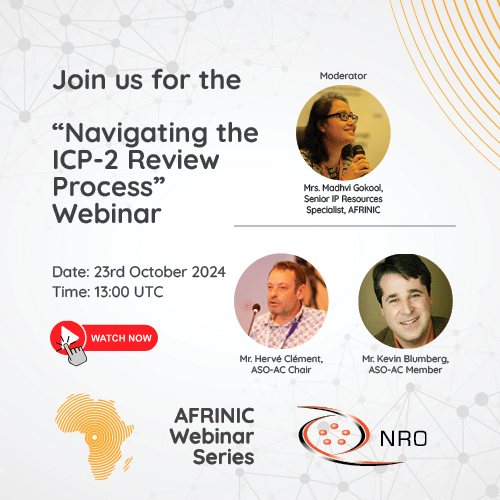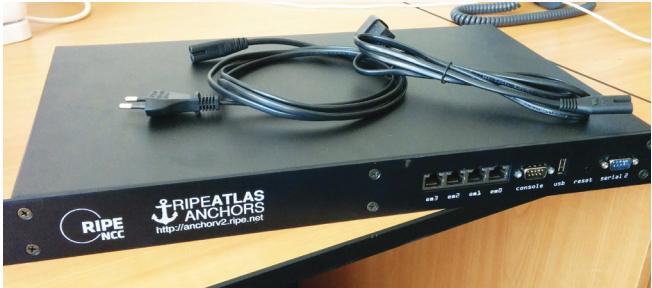
Africa Internet Measurement (AIM)
 The AIM Programme is an AFRINIC initiative. It aims to build a network of Internet measurement researchers, engineers, and institutions in Africa to:
The AIM Programme is an AFRINIC initiative. It aims to build a network of Internet measurement researchers, engineers, and institutions in Africa to:
- create awareness about Internet measurement, the need to and the benefits of conducting measurements
- conduct world-class research in the area of Internet measurement in Africa
- increase the coverage of measurement platforms in the region and ensuring the devices are kept online
- enhance cooperation with Internet measurement infrastructure providers
- generating high fidelity internet measurement data from the region
- increase the number of workshops and training on Internet measurement at conferences and forums across the region
A detail description of the programme is available in this brochure
RIPE Atlas is a global network of probes that actively measure Internet connectivity and reachability, providing an unprecedented understanding of the state of the Internet in real time.
Since its start in 2010, the RIPE NCC has distributed 9,250 of these little probes all over the globe. People are generally very excited to participate in this project, not only because it helps improve our understanding of the Internet as a whole for the benefit of everyone, but also because there are a lot of personal benefits for those hosting probes in their networks.
You might recognize the current probe version as a wireless router, and that’s indeed what it is when we buy it off the shelf. However, the RIPE NCC adds its own firmware to it and connects it to a hierarchical control and data collection service, which, the RIPE NCC also built and maintains. RIPE NCC makes the probe source code publicly available because it wants everyone to have the opportunity to contribute to RIPE Atlas at the core level.
Once the probe is connected to your network, it constantly performs a set of built-in measurements: ping, traceroute, SSL, DNS queries to the root name servers and limited HTTP measurements. It does not look at traffic or content.
The RIPE NCC collects data produced by all these probes and provides Internet maps, tools and visualisations based on the aggregated results. The data is also made available to anybody who wants to study the health of the Internet.
A system has been built in many safeguards to prevent anyone from taking over the system. For example, the probes don’t have any open ports that one can connect to (even locally) - they only support outgoing connections. The probes also use mutual authentication between the probes and the infrastructure components. Of course, it cannot be absolutely certain that an attack could not be carried out. The limited capabilities and the obscurity of the individual probes make the system an unattractive target, and that the current protection mechanisms are adequate.
In addition to the built-in measurements, anyone who hosts a probe earns credits they can use on their own customized measurements to gain valuable information about the reachability of their own (or their ISP’s) network. You can generally see which destinations you can reach from your network and via which paths. But with the help of RIPE Atlas, you can also do the reverse and check the reachability of your network from a distributed network of vantage points around the world.
There are thousands of active probes in the RIPE Atlas network, and it is continually growing. Even if you don’t host a probe yourself (or there are already enough in your region), everyone can access the data made available by other RIPE Atlas users. You can browse the measurements towards your country or ASN, for example, or towards a hostname of interest. There are various user interfaces available, including maps, a searchable, web-based interface, an API and various other ready-to-use tools and visualizations.
RIPE Atlas Anchors are located at hosts that can provide sufficient bandwidth to support a large number of incoming and outgoing measurements. Based on this requirement, RIPE Atlas users can schedule measurements originating from anchors. In this sense, anchors act as probes, but with much greater measurement capacity than regular probes.
RIPE Atlas users can schedule measurements targeting anchors. The anchor names are encoded in such a way that they display their country and city location as well as the Autonomous System Number in which they are situated. This way, RIPE Atlas users get to choose from a list of regional targets (anchors) in different networks and in different geographical locations.
Each RIPE Atlas anchor can be used as a target for the following measurements: ping, traceroute, DNS, HTTP(s).
The RIPE NCC schedules baseline measurements, called anchoring measurements, towards the anchors. These ongoing measurements are performed by hundreds of probes from the RIPE Atlas network.
Anchors provide valuable information about local and regional connectivity, both for those hosting a RIPE Atlas anchor and for the entire Internet community. In addition to performing more measurements themselves, RIPE Atlas anchors also act as well-known and co-operating targets for user-defined measurements set up by probe hosts throughout the RIPE Atlas network.
To recognise this service to the community, RIPE Atlas anchor hosts earn additional credits.
To host a probe, you need to an Ethernet port on your home/office router, switch, etc, to which you will connect the probe. You will also need a USB power outlet to power the probe. In many cases, there is one on your switch/router. You may also use a USB charger to connect the probe to a power supply.
- Create a RIPE Atlas account here.
- Verify the e-mail used by clicking the link sent to your e-mail.
- Probes could also be obtained from AFRINIC and other RIPE ambassadors during the different Internet-related forums in the African region OR directly from RIPE Atlas by filling this form https://atlas.ripe.net/apply/?source=ec541a36-caaf-475e-9f81-ab18ef793acd.
In most networks, the probe will get an IP address as soon as it is connected using the DHCP service on the network and no further configuration is needed afterwards. If you do not have a DHCP service running on your network, a static IP address has to be configured in the probe – static configuration is necessary for an IPv6-only network. Follow the guide on this RIPE page for static configuration of probes.
Note that bandwidth usage depends on the type of measurement the probe is running. You can always check your probe's bandwidth usage on the probe's detailed information page.
RIPE Atlas anchor could be hosted as a hardware or a virtual machine but the requirements are mostly the same as detailed below. Note that AfriNIC sponsors a number of hardware Anchor deployments on IXPs every year but also provides support for virtual anchor deployment on the IXPs as well as other networks. To be able to implement the Atlas Anchor please ensure that you have:
A management network consisting of:
|
A Management Network consisting of: If you have either of the above network topologies, please confirm that you are able to provide the network requirements below; 1. The anchor may require up to 10 Mbit bandwidth (it currently requires much less) |
Optional - IPv6 address (if IPv6 is announced in the host ASN) needs to be native and unfiltered (NO firewall)
If interested and willing to participate in either type of deployments (VM or Hardware) and are able to meet the outlined requirements, please get in touch via This email address is being protected from spambots. You need JavaScript enabled to view it. in order to have more information about how to start the process.


